How to Bend and How Not to Bend
Round-backed bending is ubiquitous in modern urban culture. It damages the back. Recognizing this, many health advocates recommend bending at the knees. Done to excess or with poor form, this damages the hips, knees, ankles, and feet.
Surprisingly, poor bending form abounds even in fitness and wellness classes.

An insistence on touching the toes can be counterproductive and result in damage
People sometimes equate being able to touch the toes with flexibility. An imprecise and insistent pursuit of this kind of “flexibility” causes disc damage, hyper-extended spinal ligaments, and a lot of pain. Let’s examine do’s and don’t’s in bending more closely.
DO
- Come close in to your tasks and don’t bend if you don’t need to.
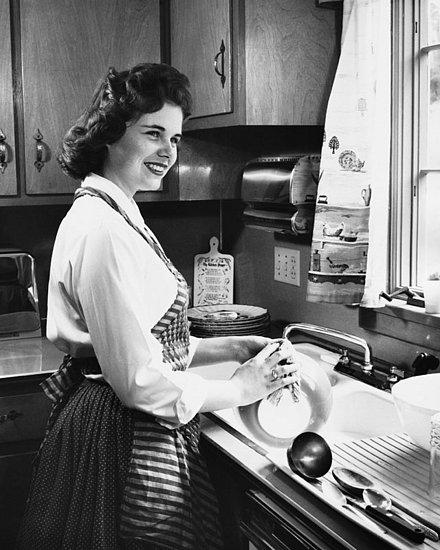
If you can accomplish your task without bending, don’t bend.
- Be sure your legs are externally rotated so there’s room for your pelvis when you bend.
If your thigh bones (femurs) are in the way of the pelvis settling between the legs in a forward bend, there’s no healthy workaround for bending. Widening your stance can help some, but a healthy bend needs external leg rotation no matter where your legs are positioned.
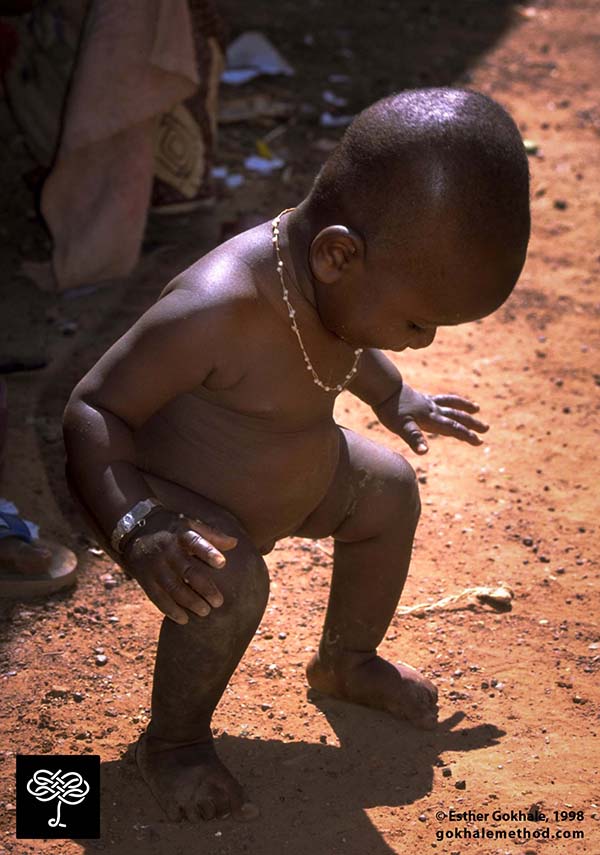
This Burkina baby has his legs externally rotated, making room for his pelvis and substantial belly!
- Maintain the shape of your back when bending
The spine carries precious cargo - like all the nerves and nerve roots that exit between the vertebrae - and these are threatened by major distortions of the spine.
In activities other than bending, some movement around a healthy baseline is healthy and desirable. Such movement stimulates circulation and helps maintain healthy spinal tissues.
For bending, I recommend strictly maintaining the baseline shape of the spine. Distorting the spine when bending loads the discs and can cause damage. It also sets a risky pattern for bends that involve weight-bearing. I recommend pure hip-hinging for all bends, whether in daily life or exercise. With practice, good form, and strengthened inner corset muscles, you will be able to move into sustained bending and lifting weights.

Women in the marketplace in village Orissa demonstrating excellent hip-hinging form.
- Maintain (or increase) the length of your spine when bending
You don’t want to load your discs when bending. This happens when rounding or swaying the back, or from additional muscle engagement while maintaining your baseline spinal shape. Using the inner corset (go here for a free download of Chapter 5 from 8 Steps to a Pain-Free Back) while bending is excellent insurance against loading the discs unwittingly.
- Practice bending with a teacher and with mirrors
If you are accustomed to tucking your pelvis, it can be a real challenge to find the correct movement in the hips. Practice bending in front of a mirror, or, better yet, with a Gokhale Method teacher, so you get the feel of healthy hip rotation with a straight back.
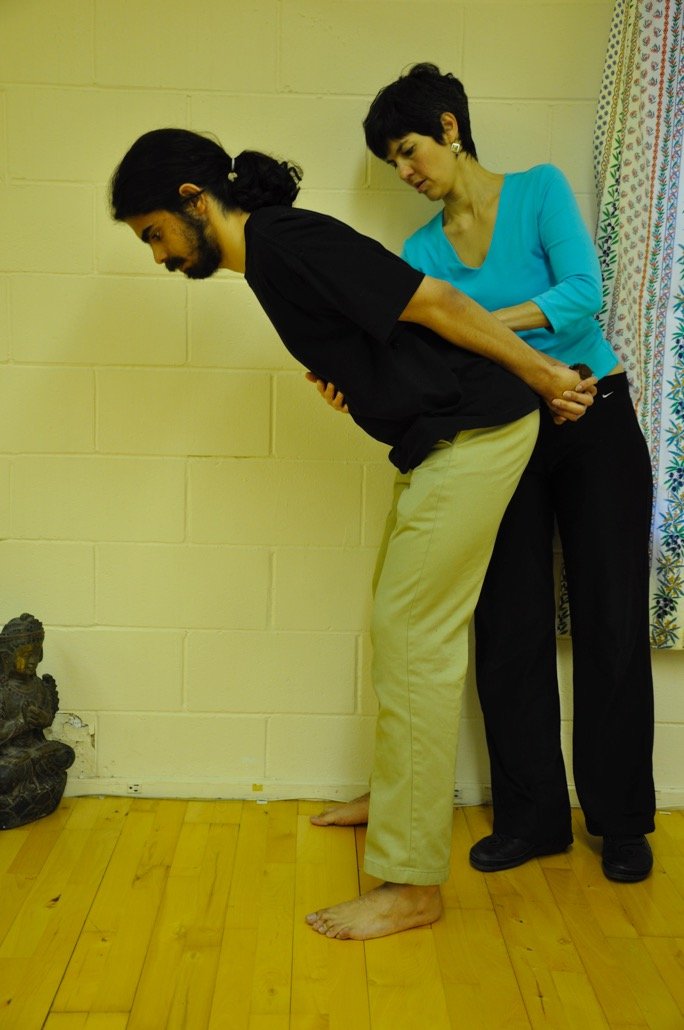
Working with a teacher helps set a healthy hip-hinging pattern
Start off with small bends - pay attention when you are at the sink or making your bed. Keep your feet and knees pointed out 10-15 degrees, have your knees soft and only bend at the hips as far as you can before you start to round. At that point, enjoy the gentle stretch in your hamstrings and external hip rotators. Bend your knees if you want to go any further. For more complete hip-hinging instructions and images, refer to Chapter 7 of 8 Steps to a Pain Free Back or Back Pain: The Primal Posture Solution (DVD).
DON’T
- Don’t Round the Lower Back.
The most common mistake in bending is to round the back, either distributing curvature throughout the spine or concentrating most of it in one spot. If your pattern of bending includes rounding the lower back, this is a particularly risky mistake. Being at the bottom of the heap, the lumbar discs are already particularly vulnerable to wear and tear, bulging, herniation, and sequestration. Rounding the lower back while bending puts additional strain on them. The amount of loading is high because our upper bodies are heavy (especially our heads) and the lever arm is long (Torque = weight X distance.)
You may know people who bent to tie their shoelaces or perform some other seemingly innocuous task on the ground, and then couldn’t straighten back up. Those people were probably rounding their lower backs, possibly with the additional danger of a twist added in. The brain reacts to the threat / damage by seizing up muscles in the area. Ouch! In my classes I go so far as to say that people who bend well will probably never have a back problem, while people who bend poorly almost certainly will. It's very important to get bending right!
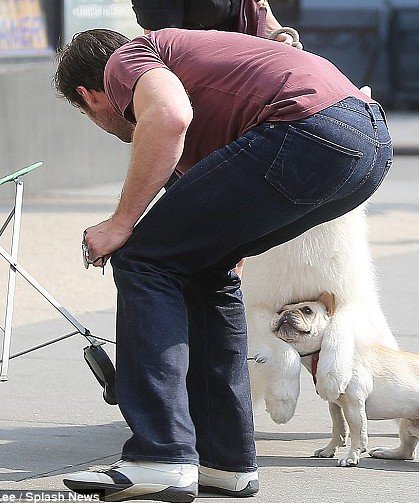
Hugh Jackman rounding his back while bending
- Don’t Round the Upper Back.
Rounding the upper back is problematic for an entirely different reason. The discs in the upper back don’t generally herniate or get severely damaged. This is partly because the rib attachments to the thoracic vertebrae help fortify that portion of the spine. The problem that results from repeatedly rounding the upper back while bending is that the spinal ligaments gets distended.
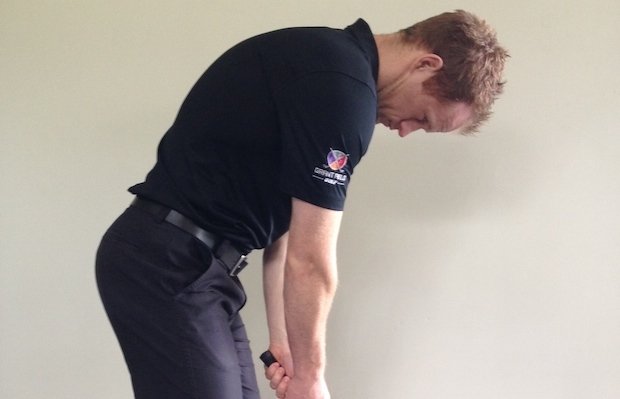
Avoid rounding your back and letting your shoulders come forward while bending
Ligaments are like band-aids that go from bone to bone and whose function is primarily structural support. They are a backup system for our muscular support. In situations when there is more challenge and distortion than our muscles are strong enough to handle, or when muscles don’t have time to fire, such as in a jolting accident or jump, then the ligaments keep our joints safe.
Ligaments are supposed to have some degree of stiffness. Ligaments aren’t an elastic kind of tissue. Once stretched too far, they are permanently distended, and no longer serve their role as the backup system to support the spine. Extreme forward bends that come from the back and not the hips cultivate ligamentous laxity more than muscular flexibility. It is counterproductive and results in losing important structural insurance. This is what we see happening in the backs, hips, and knees of athletes and yogis who push too far in poorly executed forward bends as well as other distortions.
Charlotte Bell, an Iyengar yoga teacher and author of Mindful Yoga, Mindful Life, had a hip replacement in 2015. She warns us “I know a number of serious practitioners who are now in their 50s—including myself—who regret having overstretched our joints back in the day. All too many longtime practitioners now own artificial joints to replace the ones they overused.”
- Don’t bend with your legs internally rotated and/or tail tucked
When the legs are internally rotated (toes and knees pointed inwards), the head of the femur grinds inappropriately against the hip socket (acetabulum), wearing down the cartilage and causing arthritic change.
In 2013, Lady Gaga canceled her “Born this Way” tour due to chronic pain from a severe cartilage tear in her hip. Lady Gaga is known for being health conscious and a yoga enthusiast. Though dancing in high heels night after night certainly puts wear and tear on the body, a yoga practice should support, not exacerbate the problem. “My injury was actually a lot worse than just a labral tear,” she told reporters. “...The surgeon told me that if I had done another show I might have needed a full hip replacement. It took over two years after my surgery to be able to correct my alignment and continue working.”

Lady Gaga internally rotating her legs while standing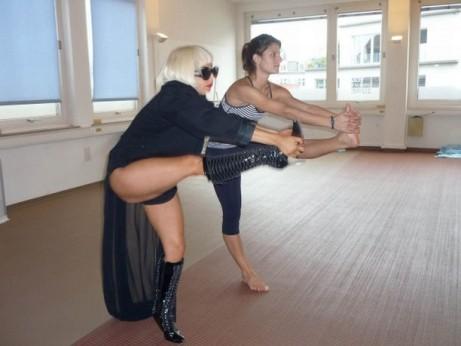
Lady Gaga bends forward in the yoga pose with toes pointed in and a tucked pelvis.
These pictures of Lady Gaga show that a) she has a tendency to internally rotate her legs while standing and b) she bends forward in the yoga pose with toes pointed in and a tucked pelvis. This puts stress on the hip joint, pushes the ball of the femur into the cartilage of the hip socket, and can overstretch the ligaments of her spine, sacroiliac joint, hip, knee, and foot.
- Don’t push beyond your range of motion in the hips
If you run into resistance in your hip joints when bending, don’t force past it. Dr. Chris Woollam, a Toronto sports medicine physician, says he started seeing “an inordinate number of hip problems” among women aged 30 to 50 who were practicing yoga. “Maybe these extreme ranges of motion were causing the joint to get jammed and some to wear,” Woollam says. “If you start wearing a joint down, then it becomes arthritic. So you’re seeing these little patches of arthritis in an otherwise normal hip that seems to be related to these extremes of motion or impingement or both.”
I suspect that some of the hip problems that get chalked up to extreme range of motion, are actually due to alignment problems. Most yoga classes, Pilates training, and gym routines teach students to stand with parallel feet. By Gokhale Method standards, this constitutes internal leg rotation. Indigenous people have their feet facing outward in the range of 5-15 degrees, and their legs are correspondingly externally rotated. It is our opinion that instructions to have parallel feet contribute to stress and arthritic changes in the hip joints, especially when combined with forward bends and other hip motions.
How well do you stack up when bending in your daily life and when exercising? How far along are you in your hip-hinging journey?
Join us in an upcoming Free Workshop (online or in person).
Find a Foundations Course in your area to get the full training on the Gokhale Method!
We also offer in person or online Initial Consultations with any of our qualified Gokhale Method teachers.

Comments
Hi Esther,Thank you for this
Hi Esther,
Thank you for this post - I love all your posts. This one was especially helpful for me because I have some arthritis in both hips and am working hard to keep things from getting any worse. So thank you!
I have a question about foot turnout (rotation). Katy Bowman - a blogger/writer who erroneously advocates for the feet to face forward - says to line up the foot by the outside rather than the inside. If you do this, the foot looks to be pigeon-toed and she says this is correct (!!!). My question for the Gokhale Method is do we find this 5-15 degree turnout by lining up the feet on the outside (as Katy suggests) or maybe from an imaginary line down the middle of the foot? If I line up as Katy Bowman says and then turnout 15 degrees the foot still looks as if it is pointed straight forward.
Sorry this is a kind of stupid question. I'm assuming you will say line up to an imaginary line going right down the middle of the foot but I just want to double check. These small details are important!
Thanks again,
Tara
I was wondering the same
I was wondering the same thing as mulaambu. Katy says to "unduck" the feet and externally rotate the thighs so knees are straight. This will allow for proper "smear." I think that's about how she puts it. Kelly Starrett adds to squeeze the buttocks to help with external rotation (which I've noticed helps achieve a "J" back shape.
In my experience, people
In my experience, people sometimes point their feet unnaturally facing out (more than 15 degrees) as an attempt to get the rest of the legs in a decent alignment. So it would be coutnerproductive to guide such a person to bring their feet facing more inwards. They need to learn to externally rotate their thighs first.
The gluteus medius is a major contributor to helping the legs externally rotate, but it works best if accompanied by the correct amount of pelvis anteversion (another area of disagreement with Katy and Kelly). Also, we Gokhale Method teachers believe it's important to learn to use this muscle as a natural part of walking. It's great to identify this muscle, as well as warm it up and begin strengthening it by squeezing it while standing, but without learning to use it in walking, it's still going to be a weak muscle and the legs will not align well.
Squeezing the gluteus medius muscle can help to antevert the pelvis if it's already in the ballpark of being well-positioned. If a person tucks their pelvis, squeezing this muscle can actually result in further tucking the pelvis. Sounds like you are already sufficiently anteverted that this move works well for you - yay!
Thank you for your time,
Thank you for your time, Esther. I've been working on tucking my chin, rolling my shoulders one at a time and my J back for a couple years now and my back pain is non-existent, thanks to you. Engaging my glutes while walking is not natural yet, but I'm always thinking about it! Thank you again!
Bonnie
Onward and upward. Keep
Onward and upward. Keep searching for that glute action - it's in there some place!
Add New Comment
Login to add commment
Login